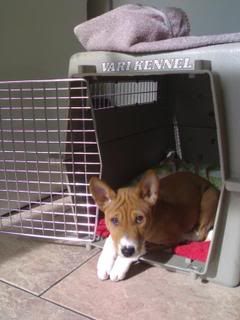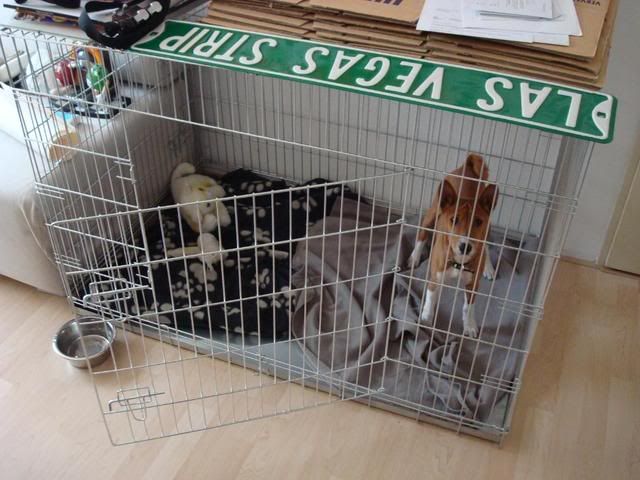Crate size
-
Hi,
Not sure where to post this question, but I'll stick it here anyway! What size crate do people use for their basenjis? I have a small size but I'm wondering if I'll have to upgrade to a medium. My Jessie is 7 months old, and when she lies down she fills up the long part of the crate (although if she curls up in a ball it doesn't look so bad). I'd rather not buy a larger one as the small one fits in nicely, but if she gets too much bigger I can see that I'll have to. Do they grow much bigger after 7 months? She's probably on the bigger side, we think she takes after her Dad than her quite small mother. At 6 months she was 12.5 kilos (28 pounds I think) at the vets when I took her to get desexed. I'm not sure what her height is.
Any advice?
ShereeI just measured her and I think she's 46-47cm (18-19 inches I think). That doesn't seem right though, aren't they only supposed to get to 40 cm (16 inches) high?
-
Not to mention there are safety issues in regard to the material and the way the crate is made. We prefer plastic crates. Miranda and I feel it helps prevent a dog getting a toenail ripped off and lessens the probability of a dog breaking a tooth is they choose to bite the wire or steel in a crate trying to get out.
We have no doubt that others feel differently.
Since dogs grow and most people do not want to have to buy more than one crate, I think many people buy a larger one than needed when the dog is in the puppy stage. We personally keep more than one size crate.
Actually our Basenji Roo has a very small crate he started with as a puppy that is now stored in the garage for the use with the next puppy or rescue dog if we get one. As Roo grew we replaced that crate with a larger one. Roo also has another crate that stays in our vehicle for travel and safety purposes.
As another said a crate should be just big enough for the dog to stand up in and turn around in. This helps in house breaking the dog.
Jason
-
Unless they are used to crates and are housetrained, giving them more room is basically allowing them more room to go to the bathroom. Typically with dogs crates should be large enough for them to do a full turn and lay down.
But a 7 month old will probably be housetrained already, right?
This was Tillo's crate when we just had him:

After a month or two he got this one:

I would never put my dog in such a small space he can only turn to lay down. If he's not housetrained, you have to make sure the pup gets out enough to go to the bathroom. Making his living space smaller seems cruel to me. Just my opinion..
-
The intent of my comment was that a smaller crate does not relieve the owner of the proper responsibilities of walking the dog at the proper times. Its not cruel at all if the dog is walked at the proper times and then move to a larger crate when the dog is house trained. In fact all the dogs I have owned never had a problem with a smaller crate but then we always walked them frequently. To this day, my Boston prefers a smaller crate because she feels safe in it. We have tried a larger one with her but she always chooses the smaller.
Jason
-
My two B's share a really big crate - the crate is big enough for a full size lab… the funny thing is, whenever i sneak up to the window to peek in on them, they are basically sitting on top of each other.
-
I had a small wire crate for Dallas when he was a puppy because I was told & read that it makes potty training much easier. If you allow them too much space, they will start a "bathroom area" within the crate & for those who don't know, it is VERY difficult to break a dog's habit of going to the bathroom inside the crate.
Anyway, I switched Dallas over to a large crate [big enough for a huskey!] when he was about 8 months old or so. Although they say that Basenjis cannot be fully trusted to be house broken until about a year old, I felt Dallas was fine. He went about 2 months without going inside the house. He loves his crate now, as it allows him ample space to stretch out, play, etc. However, that being said, if/when I get another puppy, I will be putting them inside the small crate again until they are properly house trained.
Oh & his crate now is plastic. When I bought the bigger crate I decided to go with plastic vs. wire. Although I switched not for fear of injury but because Dallas learned how to pop the side off the metal one & escape. There is currently duct tape covering the entire doorjam to my bedroom, where Dallas decided to try to dig & eat the carpet to get out of the bedroom, after the first time he was able to pop the side off :rolleyes:
-
I had a small wire crate for Dallas when he was a puppy because I was told & read that it makes potty training much easier. If you allow them too much space, they will start a "bathroom area" within the crate & for those who don't know, it is VERY difficult to break a dog's habit of going to the bathroom inside the crate.
That's exactly it.
-
Not to mention there are safety issues in regard to the material and the way the crate is made. We prefer plastic crates. Miranda and I feel it helps prevent a dog getting a toenail ripped off and lessens the probability of a dog breaking a tooth is they choose to bite the wire or steel in a crate trying to get out.
We have no doubt that others feel differently.
Jason
Yeah, there are pros and cons and safety issues with any crate. I think it depends largely on the individual dog and how he will react.
we started with a large plastic crate for Jazz and it was fine. She never had crate issues though. She probably would have been fine in a cardboard box, LOL.
We started with plastic for Keoki but moved to wire. He actually was able to break off plastic pieces from the inside! I was afraid he'd eat it. The edges where he'd torn the plastic were extremely jagged and sharp and I was afraid he'd cut himself {I scratched myself on it more than once!} The wire door was a concern for his toes and teeth for me as he dug and pulled at it constantly.
With the wire crate, he simply doesn't panic and doesn't pull or bite or attempt to break out at all. It eliminated his crate problem.
The couple of times he has wanted out, he has simply opted instead to tear unstuff his bed instead of fight the crate.It was unbelieveable to me how huge HUGE a difference the wire crate made to him….should have listened to the folks here sooner,when they recommended the wire crate to help with crate anxiety :rolleyes:
Right now we have them both in one large wire crate - probably 4 ft long and 3 ft high. We have never had issues of either dog urinating or defecating in the crate beyond puppyhood.
-
we started with a small wire crate for Jackpot. As he grew we bought the largest wire crate & it had a little wire divider thing that we could put in and decrease the size inside if we want him to have less room.
So, what I was thinking was for ppl who are getting puppies it might be wise to get the big one that has a 'movable divider' and that way you don't waste money on 2 crates & can just adjust the larger one as your B grows!
-
I prefer the wire crates and have always used them. For traveling, in my Van I use General Cage #200. In the house and when I had the RV, I use the General Cage #300 and for Whelping… I use the General Cage #400. I have never used Dividers, but then I didn't have to crate mine as pups (or adults) during the day, since we have a dog room set up with doggy door outside.. so the crate was just for eating, sleeping and traveling
And you can get dividers for the General Cages... some of mine are over 17yrs old and still going strong.
-
Thanks for your replies. She can lay down and turn around, although she looks a bit hunched if she's sitting. She's only in there while the kids have snacks, or if we have visitors and she's not behaving, and at night times to sleep (so that's the longest time). Other times I put outside in the yard.
So it's probably alright for now. I'll keep an eye on it and I expect to eventually let her have freedom at night rather than keeping her in the crate anyway. Toilet training isn't a problem when it comes to her crate. I think I'll probably try and get a second hand medium crate anyway, as I feel sorry for her all hunched up when she sits. But I'll wait until one comes along.
Thanks again! -
Indy has a "Large" size wire crate from walmart. We decked it out with a king size comforter, two fleece blankets, and a life size "puppy" stuffed animal. Then we throw in a deer antler and two of his favorite stuffed toys and tell him to have at it. So far no problems. The other cool thing about this crate is that dh made him a "deck" ontop. We put the kennel next to the couch so he can climb up the top and onto the deck. He hangs out there and looks out the window all day long sometimes.
When he was younger we put the divider in, but once he showed us that he knew pottying in his crate was not ok we just let him have all the room. So far so good.
